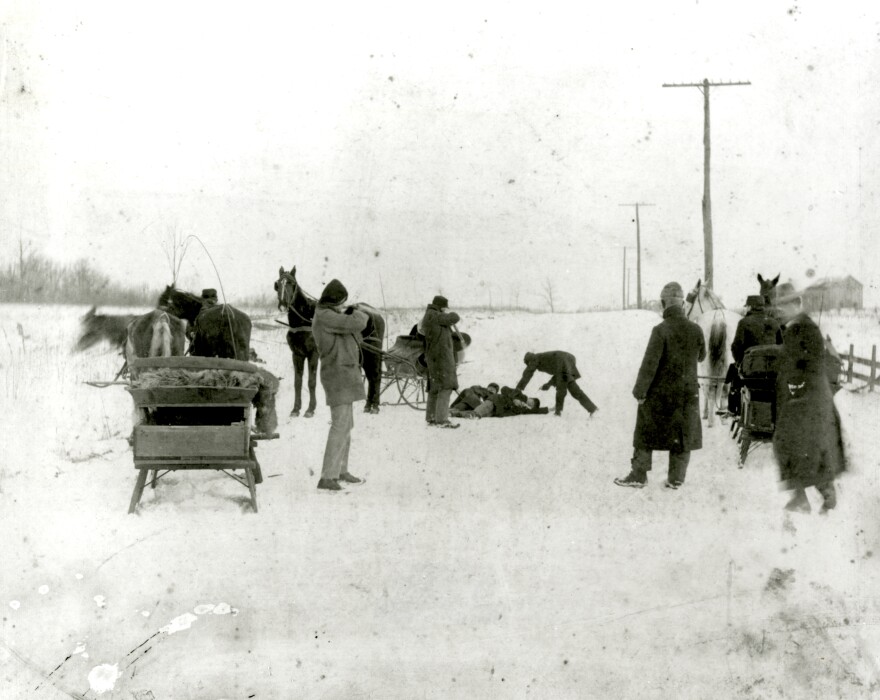The old Allegheny County Jail towers over Ross Street. Built of foot-thick blocks of pink Worcester marble, the complex hasn’t held a prisoner since July 27, 1995, but it still manages to impart a chill. Inside, visitors can tour an old cellblock: small and bleak.
Bob Loos, a Pittsburgh History & Landmarks Foundation (PHLF) docent, banged one of the cell doors repeatedly to mimic what a day in the prison would have sounded like.
“This is what you would hear throughout the jail,” he said over the hollow finality of the door slamming shut. “All. Day. Long.”
Next, Loos pointed out the stone wall.
“Look at how deep it is. There’s no handholds, no footholds. No way,” he said.
Loos’ grim “no way” refers to the possibility of escape. But Jack and Ed Biddle would have disagreed, said John Schalcosky, president of the Ross Township Historical Society.
“Born in Ontario, Canada, [the Biddle Brothers] make their way down here to Western Pennsylvania and form a small gang called the chloroform gang, which was a nonviolent way to rob people’s houses,” he said.
The six-person chloroform gang terrorized the city with a rash of burglaries and then turned deadly on April 12, 1901. In the midst of a heist, the Biddle brothers shot and killed Thomas Kahney, a Mt. Washington grocer. Detectives Charles “Buck” McGovern and Patrick Fitzgerald cornered the brothers, but Fitzgerald was killed in the encounter. The brothers were put on trial, found guilty, and sentenced to die by hanging.
Conditions were far from pleasant, said James Weddell, another PHLF docent.
“Any sane person would want to leave,” he said. “With the opportunity that presented itself with Mrs. Soffel, it would have been pretty hard to resist.”
Kate Soffel was the warden’s wife. It wasn’t uncommon for her to visit prisoners, but she spent an uncommon amount of time with the Biddle boys, said Schalcosky.
“They were very, very good-looking guys," he said. "And they were very charming.”
According to newspaper accounts, Ed was so good-looking that the ladies of Allegheny County opined his innocence. And so charming that Mrs. Soffel — mother of four, married to one of the city’s most prominent justice figures — fell in love with him; she agreed to help the brothers escape and run away with them. In a letter to Kate, Ed wrote in a manner that was by turns endearing and terrifying, said Schalcosky.
“She knew that if she crossed him, that that was the end for her, too,” he said.
Kate smuggled saws to the Biddles for getting through the iron bars and even brought them one of the warden’s guns, an event to which her father, the deputy warden, turned a blind eye. In the early morning hours of Jan. 30, 1902, the escape began.
“Kate Soffel chloroforms her husband,” said Schalcosky. “Meanwhile, Ed Biddle fakes being sick. The guard goes to get some medicine. [Ed] takes away the iron bars and slips out of his cell.”
Ed and Jack threw one guard over the rail, shot another, and corralled all three in a basement cell. They dressed in the jailers’ suits and ties, snuck through the warden’s house and hoofed it to Allegheny City, said Schalcosky.
“They took a trolley all the way to the end of the line, which was West View at the time,” he said. “And they made their way by foot to the Perrysville Schoolhouse.”
It was about 11 a.m., and back in Pittsburgh, Buck McGovern — the detective who originally brought the Biddle Boys in — was livid. He alerted Butler County police that two fugitives were headed north, likely for Canada. He rounded up eight detectives and gave chase.
“Nightfall comes around,” said Schalcosky. “Ed Biddle goes out to the White House Hotel. He asks for six ham sandwiches and a pint of whiskey. He doesn’t have enough room in his overcoat so he pulled out his gun and put it on the bar. Right there is where Christ Weller — the bartender at the time — knew something was up.”
After dinner, the crew stole a one-horse sleigh from the Schwartz dairy on Three Degree Road in present-day Ross Township and continued north, said Schalcosky.
“They all made a suicide pact that if they were going to get caught, they would just shoot each other or shoot themselves instead of being taken by the law,” he said.
By the time the threesome reached Cranberry, the horse was on its last legs, but they pushed on to Butler, Pa. In the early morning of Feb. 1, 1902, they were ambushed by the police.
“This is Buck McGovern with his big posse of people coming for them with big rifles,” said Schalcosky. “They ended up panicking and having a big shootout.”
Riddled with gunshot wounds, Jack and Ed died at the Butler County Jail just two days after their escape. Kate spent 20 months in Western Penitentiary and died of typhoid fever in 1909, said Schalcosky.
“It’s a real life Rome and Juliet story, but this caused a great deal of grief to other people,” he said.
Buck McGovern, foe to lawlessness, went on to form the Allegheny County Police. He published a pamphlet warning against the dangers of “the HOLD-UP MAN.” The “desperate criminal of the age” who “doesn’t care ‘the snap of his finger for human life.’”
It’s easy to imagine he was thinking of the Biddle Boys.
90.5 WESA Celebrates Inventing Pittsburgh is supported by UPMC.


